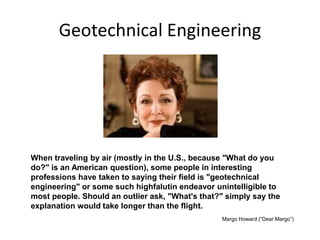Little Known Facts About Geotheta.
Wiki Article
Not known Facts About Geotheta
Table of ContentsSome Known Questions About Geotheta.The Single Strategy To Use For GeothetaWhat Does Geotheta Mean?Some Ideas on Geotheta You Should KnowGeotheta Fundamentals Explained

They conduct site examinations, collect examples, execute research laboratory examinations, and analyze information to review the viability of the ground for building jobs - Geotechnical Engineers. Based upon their searchings for, geotechnical designers offer recommendations for foundation design, slope stability, keeping frameworks, and reduction of geotechnical threats. They collaborate with other professionals, such as architects, architectural engineers, and building teams, to guarantee that geotechnical factors to consider are incorporated right into the general task style and application
By analyzing the habits and residential or commercial properties of dirt and rock, they can recognize prospective geotechnical dangers such as landslides, dirt negotiation, or slope instability. Their know-how assists avoid failures or mishaps that could jeopardize lives and building. Below are some comprehensive responsibilities and responsibilities of a geotechnical designer: Website Investigation: Geotechnical designers conduct website examinations to collect data on subsurface problems.
They interpret the data to recognize the buildings and behavior of the soil and rock, including their toughness, leaks in the structure, compaction characteristics, and groundwater conditions. Geotechnical Analysis and Layout: Geotechnical engineers examine the data collected during site investigations to examine the stability and suitability of the site for building jobs. They execute geotechnical calculations and modeling to assess elements such as birthing capacity, settlement, slope stability, lateral planet stress, and groundwater circulation.
The Greatest Guide To Geotheta
Foundation Design: Geotechnical designers play a critical role in creating foundations that can safely sustain the desired structure. They examine the dirt conditions and load needs to figure out the appropriate structure type, such as superficial foundations (e.g., grounds), deep structures (e.g (http://peterjackson.mee.nu/do_you_ever_have_a_dream#c2153)., heaps), or specialized techniques like dirt renovation. They take into consideration aspects such as negotiation limits, birthing ability, and soil-structure communication to develop optimal structure layoutsThey examine construction plans, monitor website activities, and perform area examinations to validate that the style recommendations are adhered to. If unforeseen geotechnical concerns emerge, they assess the circumstance and offer suggestions for removal or changes to the design. Threat Evaluation and Mitigation: Geotechnical engineers analyze geotechnical threats and risks connected with the project website, such as landslides, liquefaction, or dirt erosion.

Collaboration and Communication: Geotechnical engineers function very closely with other experts associated with click here to find out more a task, such as designers, structural designers, and building groups. Reliable communication and cooperation are vital to integrate geotechnical factors to consider right into the general job style and construction procedure. Geotechnical engineers supply technological expertise, solution queries, and ensure that geotechnical demands are fulfilled.
More About Geotheta
Here are some sorts of geotechnical designers: Structure Engineer: Structure designers focus on making and assessing structures for structures. They examine the soil conditions, lots needs, and website features to establish the most appropriate structure kind and design, such as shallow structures, deep foundations, or specialized techniques like pile structures.They assess the elements affecting slope security, such as dirt properties, groundwater conditions, and incline geometry, and establish techniques to avoid incline failures and reduce threats. Quake Engineer: Earthquake designers specialize in analyzing and designing structures to hold up against seismic forces. They examine the seismic danger of a site, examine dirt liquefaction capacity, and establish seismic layout criteria to guarantee the safety and strength of frameworks throughout quakes.
They execute field testing, gather samples, and assess the gathered data to identify the soil residential or commercial properties, geologic developments, and groundwater conditions at a website. Geotechnical Instrumentation Engineer: Geotechnical instrumentation designers focus on surveillance and measuring the habits of soil, rock, and frameworks. They mount and keep instrumentation systems that keep an eye on aspects such as soil settlement, groundwater levels, slope motions, and structural displacements to evaluate efficiency and give early warnings of potential problems.
How Geotheta can Save You Time, Stress, and Money.
They conduct tests such as triaxial tests, loan consolidation tests, straight shear examinations, and permeability tests to gather data for geotechnical evaluation and layout. Geosynthetics Designer: Geosynthetics designers concentrate on the style and application of geosynthetic materials, such as geotextiles, geogrids, and geomembranes. They make use of these products to enhance dirt security, strengthen inclines, provide water drainage solutions, and control erosion.They often tend to be investigatory individuals, which means they're intellectual, introspective, and curious. They are curious, methodical, rational, logical, and logical. Some of them are additionally social, suggesting they're kind, generous, cooperative, client, caring, valuable, compassionate, tactful, and friendly - Tailings Engineer.
In the office setting, geotechnical designers use specialized software devices to execute estimations, produce styles, and evaluate information. They prepare records, review task specs, communicate with customers and team participants, and coordinate job tasks. The office setup supplies a favorable environment for study, evaluation, and partnership with other professionals associated with the project.
The Best Guide To Geotheta
They regularly go to job websites to conduct site investigations, analyze geotechnical conditions, and gather data for analysis. These brows through include taking a trip to various places, occasionally in remote or tough surfaces. Geotechnical designers may do soil sampling, conduct examinations, and screen building and construction tasks to guarantee that the geotechnical aspects of the job are being applied appropriately.Geotechnical engineers also work in specialized geotechnical labs. In these centers, they conduct experiments, do examinations on dirt and rock samples, and examine the design properties of the products. Geotechnical research laboratory engineers work extensively in these atmospheres, dealing with testing equipment, operating instruments, and videotaping information. They collaborate with other lab personnel to make sure precise and trusted testing results.
Report this wiki page